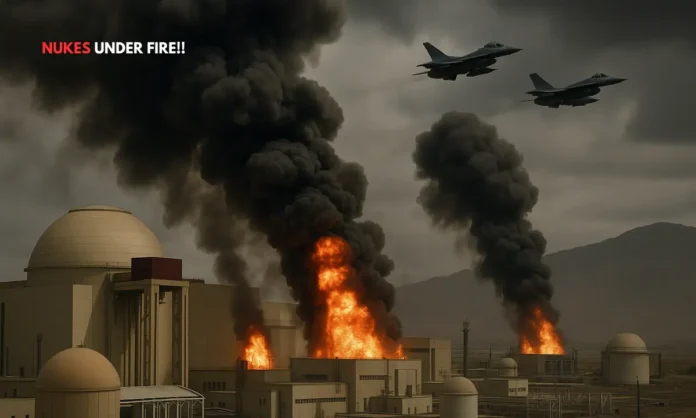Summary
- Conflicting claims have emerged over the impact of US strikes on Iran’s nuclear sites, with Trump calling it “obliteration” and intel reports saying “only months” of delay.
- Iran has responded by suspending cooperation with the IAEA and threatening to leave the Non-Proliferation Treaty.
- As diplomacy hangs by a thread, concerns grow over enriched uranium stockpiles and Iran’s likely response.
Fog of Warheads: The Fallout from a Strike That Was Supposed to End a Program
On June 21, 2025, the United States launched precision airstrikes on three of Iran’s most heavily fortified nuclear sites—Fordo, Natanz, and Isfahan—declaring it a mission to “ensure Iran never goes nuclear.” Days later, the global narrative around the attack is anything but assured.
U.S. President Donald Trump, speaking at a NATO summit, boasted that Iran’s nuclear ambitions had been “totally obliterated.” Defense Secretary Pete Hegseth called the operation “flawless.” But within 48 hours, a classified intelligence leak from the Pentagon offered a contradictory picture: the US Iran nuclear strike fallout 2025 may be far more ambiguous than the White House claims.
According to the leaked Defense Intelligence Agency (DIA) assessment, the strikes only destroyed surface-level structures. Iran’s centrifuges remain “largely intact,” and its 60%-enriched uranium stockpile—just one step below weapons-grade—was untouched. The fallout is no longer just military. It’s diplomatic, strategic, and dangerously unstable.
Breaking news: Trump does little more than create an interesting garden feature on top of Iran’s nuclear mountain. “Anonymous sources familiar with the Pentagon's assessment told US media that the unprecedented missile strikes only set Iran back 'a few months, tops'. “ https://t.co/kqmJT5qJfY pic.twitter.com/GnR4q5MMzC
— Peter Kay (🦋@theonlypeterkay.bsky.social) (@theonlypeterkay) June 25, 2025
Damage Assessment or Political Optics?
- Trump insists Iran’s nuclear program was “flattened” and the sites “perfectly hit.”
- The Pentagon report says the damage set Iran’s program back “a few months, tops.”
- Fordo, one of the main targets, is built deep beneath a mountain—hard to destroy by air.
- Ex-generals and diplomats warn of premature conclusions without on-ground verification.
- The White House denounced the intelligence leak, calling it “flat-out wrong” and “disrespectful.”
The credibility gap between battlefield reality and presidential rhetoric is widening. Trump’s proclamation of “total obliteration” has been publicly challenged by former generals, Pentagon officials, and diplomats. Retired US Army General Ben Hodges, speaking to BBC Radio, said the idea of accurate damage assessment within 24 hours was “not very wise.”
Fordo, buried beneath concrete and rock, is structurally designed to withstand attacks like this. The strikes may have damaged its entrance, but as former ambassador Daniel Shapiro put it, “We still don’t know what’s happened to about 400kg of enriched uranium.”
Trump’s statements appear designed for political optics—a victory speech broadcast before the dust had settled. But as the US Iran nuclear strike fallout 2025 unfolds, the lack of verifiable evidence is starting to undercut the administration’s credibility.
Iran’s Countermove: Nuclear Transparency in Reverse
- Iranian parliament voted to suspend cooperation with the IAEA, citing bias and inaction.
- Iran accused the UN watchdog of “putting its credibility up for auction.”
- Tehran also signaled it may leave the Non-Proliferation Treaty (NPT).
- Officials vowed the “peaceful nuclear program” would now accelerate.
- Enriched uranium stockpiles remain unaccounted for in the current reporting cycle.
If the US strikes were meant to delay Iran’s nuclear capability, they may have had the opposite effect. In what can only be seen as strategic defiance, the Iranian parliament passed a resolution to halt all cooperation with the IAEA. While the vote remains symbolic until ratified by senior clerics and the president, it sends a chilling signal to the international community.
Speaker Mohammad Bagher Ghalibaf declared that the IAEA had “failed to condemn the Israeli and US aggression,” and that cooperation would resume only when Iran’s facilities are “guaranteed security.” For now, Tehran is treating transparency as a weakness and secrecy as a strategic shield.
Already under suspicion for hiding advanced centrifuge networks, Iran may now move underground—figuratively and literally. With Fordo’s operational integrity uncertain, the regime could shift activities to undisclosed sites, further complicating any future inspections or diplomatic overtures.
Diplomatic Aftershocks and the Road Ahead
- US special envoy Steve Witkoff called for “comprehensive peace talks” with Iran.
- Iran’s leadership, shaken but not broken, says nuclear work will now “move faster.”
- Analysts warn of a potential race toward weaponization for deterrence.
- North Korea’s immunity from attacks due to nuclear capability is being cited in Iranian media.
- A ceasefire may hold temporarily, but negotiations are expected to be fraught.
The most dangerous outcome of the US Iran nuclear strike fallout 2025 may not lie in what was destroyed—but in what was provoked. Hugo Bachega, a BBC Middle East correspondent, summed it up: “Iranian leaders know a line has now been crossed… and that having such a weapon is probably their only protection from further attacks.”
Indeed, Iran’s strategic calculus may now mirror that of North Korea. Deterrence, not diplomacy, could become the dominant logic. With talks expected to resume under extreme mistrust, one key US demand—no uranium enrichment on Iranian soil—already seems like a non-starter.
Meanwhile, enriched uranium at 60% purity is only a short technical leap away from weapons-grade. And without the IAEA’s oversight, the world may have no idea how close Iran gets until it declares itself nuclear-capable.
A Strike Meant to End a Threat May Have Reignited It
The US Iran nuclear strike fallout 2025 has moved from bomb damage to political detonation. Washington may have succeeded in demonstrating military resolve, but failed to destroy Tehran’s nuclear ambition. Iran, in turn, has chosen opacity over cooperation—abandoning decades of hard-won nuclear diplomacy.
With global intelligence agencies divided, American leadership doubling down, and Iranian rhetoric intensifying, the world is now caught between competing truths. What was supposed to be a preventive strike has created the conditions for a nuclear future more unstable—and unpredictable—than ever.


